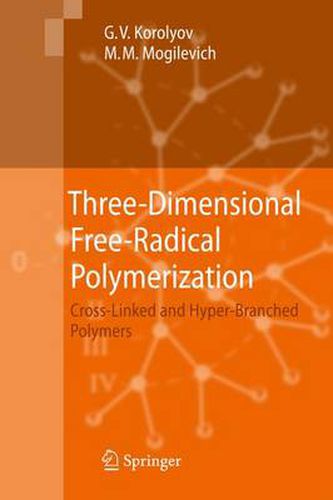Readings Newsletter
Become a Readings Member to make your shopping experience even easier.
Sign in or sign up for free!
You’re not far away from qualifying for FREE standard shipping within Australia
You’ve qualified for FREE standard shipping within Australia
The cart is loading…






This title is printed to order. This book may have been self-published. If so, we cannot guarantee the quality of the content. In the main most books will have gone through the editing process however some may not. We therefore suggest that you be aware of this before ordering this book. If in doubt check either the author or publisher’s details as we are unable to accept any returns unless they are faulty. Please contact us if you have any questions.
At present, three-dimensional free-radical polymerization (TFRP) is a special ?eld of radical polymerization. TFRP is characterized by speci?c kinetic regularities and mechanisms of processes for the formation of cross-linked or hyper-branched po- mers, and they are different from the kinetics and mechanism of classical radical polymerization. The fundamental studies of kinetics and mechanism of TFRP with formation of cross-linked polymers have been carried out in three stages. The ?rst stage lasted from 1960 until 1983, and the main mechanisms of TFRP of oligo(acrylates) were established during this stage [1-3]. Condensation telomerization, being a universal oligo(acrylate) synthesis procedure, allows us to vary certain molecular parameters, such as length and ?exibility of oligomeric blocks, number and type of reactive groups (methacrylic or acrylic groups), and chemical nature of atomic groups of an oligomeric block, which represent the centers of strong intermolecular interactions. For this reason, oligo(acrylates) were very convenient compounds for establi- ing the main kinetic regularities of TFRP and regularities of formation of polymer three-dimensional cross-linkedstructures,according totheso-calledmicrohetero- neous mechanism (G.V. Korolev, 1977), at the topological and morphological levels.
$9.00 standard shipping within Australia
FREE standard shipping within Australia for orders over $100.00
Express & International shipping calculated at checkout
This title is printed to order. This book may have been self-published. If so, we cannot guarantee the quality of the content. In the main most books will have gone through the editing process however some may not. We therefore suggest that you be aware of this before ordering this book. If in doubt check either the author or publisher’s details as we are unable to accept any returns unless they are faulty. Please contact us if you have any questions.
At present, three-dimensional free-radical polymerization (TFRP) is a special ?eld of radical polymerization. TFRP is characterized by speci?c kinetic regularities and mechanisms of processes for the formation of cross-linked or hyper-branched po- mers, and they are different from the kinetics and mechanism of classical radical polymerization. The fundamental studies of kinetics and mechanism of TFRP with formation of cross-linked polymers have been carried out in three stages. The ?rst stage lasted from 1960 until 1983, and the main mechanisms of TFRP of oligo(acrylates) were established during this stage [1-3]. Condensation telomerization, being a universal oligo(acrylate) synthesis procedure, allows us to vary certain molecular parameters, such as length and ?exibility of oligomeric blocks, number and type of reactive groups (methacrylic or acrylic groups), and chemical nature of atomic groups of an oligomeric block, which represent the centers of strong intermolecular interactions. For this reason, oligo(acrylates) were very convenient compounds for establi- ing the main kinetic regularities of TFRP and regularities of formation of polymer three-dimensional cross-linkedstructures,according totheso-calledmicrohetero- neous mechanism (G.V. Korolev, 1977), at the topological and morphological levels.